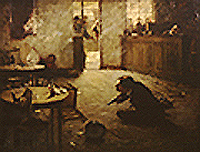Cowboys, Indians & the Big Picture
October 6–December 8, 2002
 The American West has had an enormous influence on the course of American history, mythology, and popular culture. Traditionally, the region has been hailed as the terrain in which American values of progress triumphed against great odds. The magnificence of the western landscape and the high ideals of freedom and progress that galvanized Americans to settle there also drew numerous artists to document the perilous process of westward expansion.
The American West has had an enormous influence on the course of American history, mythology, and popular culture. Traditionally, the region has been hailed as the terrain in which American values of progress triumphed against great odds. The magnificence of the western landscape and the high ideals of freedom and progress that galvanized Americans to settle there also drew numerous artists to document the perilous process of westward expansion.
Early artists such as Frederic Remington, Karl Bodmer, and Charles Russell believed their paintings of cowboys, Indians, and the Western landscape would serve as an objective historical record of western settlement. Their followers, who have adopted the palette, subject matter, and rigorously literal styles of the early western artists carry on the mission of Remington, Bodmer and Russell by generating images of the Old West as they believe it really was. This second group of artists, known as the Western Realists, draw from years of study of western artifacts, history, and in many cases their own histories as cowboys, ranchers, and rodeo riders to lend authenticity to their western scenes.
Although Western Realism retained its popularity throughout the twentieth century, the preeminence of abstraction, conceptual art, and more politically charged themes in postwar American art threatened to relegate Western Realism to a sort of second-class, regional style. A group of Western Realists, representing the most accomplished and best recognized among their peers, gathered in Sedona, Arizona in 1965 to discuss the future of Western Realism, and how they might encourage the continued production of high-quality painting, printmaking, and sculpture in the genre. Their strategy for preserving the vitality of Western Realism was to establish a society of artists whose mission was to "ensure that as society change[s], the stature of western art within the area of fine art [will] remain solidly fixed." The Cowboy Artists of America works to achieve this by holding member artists and potential member artists to high technical standards, and inducting only those who consistently produce "authentic representations of life in the West, as it was and is."
Although the CAA and its supporters have been somewhat resistant to the encroachment of more modern approaches to western subjects, a number of western artists began using modern visual language to offer alternative interpretations of Western Realists' objectively rendered images and themes. Several of these artists come from groups who were not included in developing the standard historical narrative of the American West--women, Latinos, Asians, and particularly Native Americans. These new voices are joined by artists influenced by the environmental and anti-nuclear movements, and urban westerners interested in making images of the West as they experience it, rather than how it looked in its rural past. This new body of work challenges the notion of a single reality of life in the American west, and demonstrates the diversity of styles and themes that western artists are continuing to develop.
Although the edgier, more political work confronts and challenges traditional western images and the static American progress narrative, both Western Realism and Western Modernism coexist in present-day western cultural life, with some practitioners and collectors experimenting with, and giving serious consideration to the legitimacy of both styles and the many angles of the western experience.In presenting this body of work, the exhibition aims to illustrate many Wests, offering an alternative to the debate about which images and styles represent the American West as it really was--and is-- in the present day.
Organized by the McMullen Museum, this exhibition is co-curated by Boston College faculty members Heather Fryer (History), Marilynn Johnson (History), and Eva Garroutte (Sociology). Cowboys, Indians, and the Big Picture presents 38 works from the early nineteenth-century tradition of oil painting to the contemporary, politically-oriented imagery offering a complex and multi-faceted picture of the American West. The accompanying catalogue will include illustrations and entries on all works in the exhibition and four essays by Fryer, Johnson, Garroutte, and Kate Bonansinga (Director of Art Galleries at the University of Texas, El Paso). The catalogue will be available at the Boston College Bookstore and from the University of Chicago Press.

